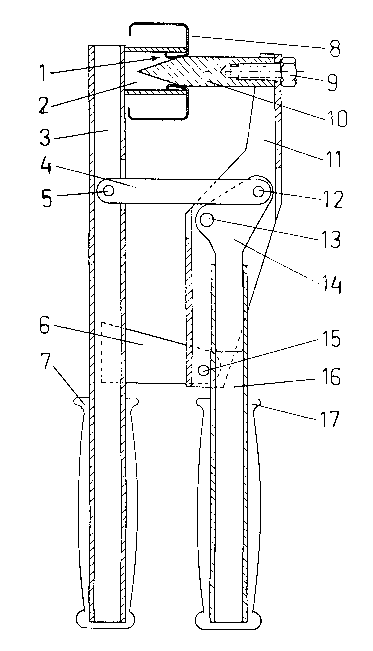Some of the information on this Web page has been provided by external sources. The Government of Canada is not responsible for the accuracy, reliability or currency of the information supplied by external sources. Users wishing to rely upon this information should consult directly with the source of the information. Content provided by external sources is not subject to official languages, privacy and accessibility requirements.
Any discrepancies in the text and image of the Claims and Abstract are due to differing posting times. Text of the Claims and Abstract are posted:
| (12) Patent: | (11) CA 2058307 |
|---|---|
| (54) English Title: | METHOD OF FORMING CABLE-GUIDING OPENINGS IN METAL WALL-STUDS AND HAND POWERED TOOL FOR IT |
| (54) French Title: | METHODE DE PERCAGE D'OUVERTURES POUR LES CABLES DANS LES MONTANTS METALLIQUES ET OUTIL MANUEL CONNEXE |
| Status: | Term Expired - Post Grant Beyond Limit |
| (51) International Patent Classification (IPC): |
|
|---|---|
| (72) Inventors : |
|
| (73) Owners : |
|
| (71) Applicants : |
|
| (74) Agent: | |
| (74) Associate agent: | |
| (45) Issued: | 1996-05-07 |
| (22) Filed Date: | 1991-12-23 |
| (41) Open to Public Inspection: | 1993-06-24 |
| Examination requested: | 1993-12-17 |
| Availability of licence: | N/A |
| Dedicated to the Public: | N/A |
| (25) Language of filing: | English |
| Patent Cooperation Treaty (PCT): | No |
|---|
| (30) Application Priority Data: | None |
|---|
A method and hand powered tool for forming openings
in metal wall-studs thereby to receive electrical
cables, which can be easily pulled through these
openings. The tool comprises pyramid-shaped piercer
attached to a jaw which is pivotally connected to
a handle having affixed hollow die. The piercer,
pushed into stud's wall by lever, forms in the stud
an opening having guiding tabs shaped from material
displaced from the area of said opening.
Note: Claims are shown in the official language in which they were submitted.
Note: Descriptions are shown in the official language in which they were submitted.

2024-08-01:As part of the Next Generation Patents (NGP) transition, the Canadian Patents Database (CPD) now contains a more detailed Event History, which replicates the Event Log of our new back-office solution.
Please note that "Inactive:" events refers to events no longer in use in our new back-office solution.
For a clearer understanding of the status of the application/patent presented on this page, the site Disclaimer , as well as the definitions for Patent , Event History , Maintenance Fee and Payment History should be consulted.
| Description | Date |
|---|---|
| Inactive: Expired (new Act pat) | 2011-12-23 |
| Letter Sent | 2007-09-25 |
| Letter Sent | 2007-09-25 |
| Inactive: Office letter | 2007-08-23 |
| Inactive: Adhoc Request Documented | 2007-08-23 |
| Inactive: Office letter | 2007-05-31 |
| Inactive: IPC from MCD | 2006-03-11 |
| Letter Sent | 2005-04-05 |
| Inactive: Late MF processed | 1998-12-21 |
| Inactive: Office letter | 1998-10-27 |
| Inactive: Office letter | 1998-02-17 |
| Letter Sent | 1997-12-23 |
| Grant by Issuance | 1996-05-07 |
| All Requirements for Examination Determined Compliant | 1993-12-17 |
| Request for Examination Requirements Determined Compliant | 1993-12-17 |
| Application Published (Open to Public Inspection) | 1993-06-24 |
There is no abandonment history.
| Fee Type | Anniversary Year | Due Date | Paid Date |
|---|---|---|---|
| MF (patent, 6th anniv.) - small | 1997-12-23 | 1997-12-30 | |
| Reversal of deemed expiry | 1997-12-23 | 1997-12-30 | |
| MF (patent, 7th anniv.) - small | 1998-12-23 | 1998-12-21 | |
| MF (patent, 8th anniv.) - small | 1999-12-23 | 1999-12-10 | |
| MF (patent, 9th anniv.) - small | 2000-12-27 | 2000-12-08 | |
| MF (patent, 10th anniv.) - small | 2001-12-24 | 2001-12-21 | |
| MF (patent, 11th anniv.) - small | 2002-12-23 | 2002-12-12 | |
| MF (patent, 12th anniv.) - small | 2003-12-23 | 2003-12-11 | |
| MF (patent, 13th anniv.) - small | 2004-12-23 | 2004-12-21 | |
| Registration of a document | 2005-02-24 | ||
| 2005-12-02 | |||
| MF (patent, 14th anniv.) - small | 2005-12-23 | 2005-12-02 | |
| MF (patent, 15th anniv.) - small | 2006-12-25 | 2006-11-30 | |
| 2006-11-30 | |||
| Registration of a document | 2007-04-25 | ||
| MF (patent, 16th anniv.) - standard | 2007-12-24 | 2007-11-30 | |
| MF (patent, 17th anniv.) - standard | 2008-12-23 | 2008-12-01 | |
| MF (patent, 18th anniv.) - standard | 2009-12-23 | 2009-12-01 | |
| MF (patent, 19th anniv.) - standard | 2010-12-23 | 2010-11-30 |
Note: Records showing the ownership history in alphabetical order.
| Current Owners on Record |
|---|
| TEXTRON INNOVATIONS INC. |
| Past Owners on Record |
|---|
| ANDRZEJ J. SZULC |